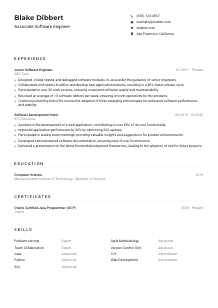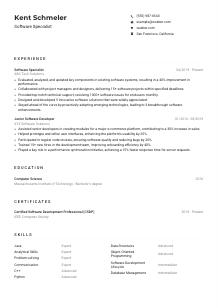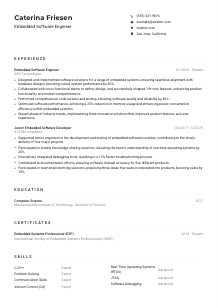Freelance Developer CV Example
Juggling code, but your CV doesn't compile? Browse this Freelance Developer CV example, fine-tuned with Wozber free CV builder. Uncover how to flawlessly present your contract gigs to sync with client requirements, paving your way to a freelance future that's always in demand!

How to write a Freelance Developer CV?
Hey there, aspiring Freelance Developer! In the realm where coding and creativity intersect, standing out is not just an aspiration—it's essential. Your CV is more than a document; it's a window into your professional soul, showcasing your technical prowess and your journey. With the help of Wozber, we've designed this step-by-step guide to sculpting a CV that resonates with your dream role.
Ready to gear up? Let's weave your professional tale into a CV narrative that will surely captivate your next client or employer!
Personal Details
First impressions count, especially in the fast-paced world of freelance development. Your personal details section is your digital handshake, so let's make sure it's firm and memorable. Tailor this section with the finesse of a seasoned coder meeting the exact specs of a project.
1. Brand Yourself with Your Name
Think of your name as your personal logo. Make it prominence with a clear font, signaling the start of a professional narrative. After all, your name is the first thing a client or recruiter will see.
2. Reflect Your Role
Directly below your name, include your desired job title: 'Freelance Developer.' This strategic placement is like your personal tagline, succinctly conveying your professional identity and immediately aligning with the applied role.
3. Essential Contact Info
Accuracy in your phone and email details is non-negotiable. A typo in your contact info could mean a missed opportunity. Opt for a professional email format like firstname.lastname@email.com to keep it straightforward and professional.
4. Location Matters
In the CV example, specifying 'San Francisco, California' not only meets a requirement but reassures clients/employers there's no relocation delay. By matching the job's geo-specific needs, you instantly elevate your candidacy.
5. Digital Footprint
Consider adding a link to your GitHub repository or professional website. This gives potential clients or employers a direct gateway to your portfolio, demonstrating your skills in action.
Takeaway
Like a well-crafted function, your Personal Details section serves a specific purpose. It introduces and brands you, declares your professional intent, and ensures anyone can reach out to you with ease. Keep it precise, aligned with the job, and ensure it reflects the professional brand that is you.





Experience
Let's dive into the core of your CV – the Experience section. This is where you get to showcase your past projects and roles, highlighting how you've left a mark in the tech world. The experience section is your proof of concept, showing you can deploy solutions that matter.
- Developed and maintained high‑quality software products, ensuring 100% adherence to coding standards and best practices.
- Led cross‑functional collaborations with designers, product managers, and team members, increasing project delivery rate by 20%.
- Optimised and debugged applications, achieving a 30% increase in speed and scalability.
- Championed the adoption of modern frameworks like React and Angular, elevating product usability by 40%.
- Provided regular status reports, resulting in 100% clarity on project goals, progress, and challenges.
- Assisted in the development and testing of web applications, enhancing user experience by 25%.
- Worked closely with senior developers, gaining proficiency in PHP and JavaScript.
- Contributed to team meetings, offering innovative solutions for project challenges.
- Participated in peer code reviews, ensuring consistent software quality.
- Completed training on emerging technologies, integrating them into company operations.
1. Dissecting the Job Requirements
Your first step is to study the job description like you would a project spec. Highlight key technologies, responsibilities, and soft skills. This helps ensure that your listed experience directly mirrors what's being asked.
2. Chronology is Key
Structure your experience chronologically, starting with your most recent project. It's like pushing your latest commits to the top of your git log; showing what's freshest and most relevant first.
3. Project Highlights
For each role, articulate your accomplishments in a way that echoes the provided job description. Use action verbs to bring dynamics to your responsibilities, like 'developed,' 'led,' and 'optimised.' This resonates more with tech hiring managers than a list of tasks.
4. Numbers Tell the Tale
Quantify your achievements wherever possible. Did you increase performance by a certain percentage? Reduce load time? Share these victories. Numbers add a tangible measure to your impact, much like performance metrics in a code review.
5. Relevance Reigns Supreme
This isn't the place to list every project you've touched unless they directly relate to the job at hand. Make every bullet count by ensuring it spells out why you're the perfect fit for this role as a Freelance Developer.
Takeaway
Think like the client scanning your GitHub repositories. Your Experience section needs to reflect value, competency, and a direct match to their needs. Focus on showing how you've faced challenges head-on with skill, creativity, and precision. This is your chance to truly illustrate your developer journey.
Education
Even in the evolving world of tech, where self-taught skills shine, a solid educational background can still give you an edge, especially when it meets specific job requirements. Let's optimise your Education section to reflect this foundational layer.
1. Spotlight on the Degree
The job asks for a 'Bachelor's degree in Computer Science, Software Engineering, or a related field.' If this matches your credentials, list it prominently. Your degree not only shows you've got the academic chops but that you meet the baseline criteria.
2. Keep It Streamlined
Format this section for easy scanning. Start with your degree, followed by the institution's name, then your graduation year. This lets hiring managers assess your educational background at a glance.
3. Degree Specifics
If the job requires a specific discipline, make sure your degree's specialization is visible. While 'Bachelor of Science' is good, 'Bachelor of Science in Computer Science' is better when the job asks for it.
4. Relevant Extras
Did your coursework include a groundbreaking project? Were you a part of a coding club? Mention any academic elements that underline your matching skill set and passion for development.
5. Other Educational Victories
Particularly for less experienced developers, noting achievements like Dean's List or scholarships can hint at your dedication and excellence. However, gauge the relevance based on the role level you're targeting.
Takeaway
Your Education section is a testament to your foundational knowledge and dedication to your craft. Ensure it highlights your relevant academic credentials and extra feats that brandish your commitment to the field of development. Remember, this section adds depth to your professional story.
Certificates
In the ever-evolving tech landscape, continuing education and certifications can keep you a cut above the rest. Whether it's a Scrum certification or a specialized programming course, your certificates can serve as badges of honor in your CV.
1. Align with the Job
The job description for our Freelance Developer didn't specify certifications, but that doesn't mean they're not valuable. Identify certifications that show your commitment to staying current, like a 'Certified Scrum Developer (CSD).' It shows you not only code but can thrive in team dynamics.
2. Highlight the Heavy Hitters
List certifications that speak directly to the role's requirements or the tech stack mentioned. This means prioritizing your Scrum certification over, say, a basic HTML course if you're applying for a role that values team project management.
3. Validity Dates
For certificates with expiration dates, make sure to include these. It reassures the client or employer of your current proficiency and dedication to maintaining your skill set in a rapidly changing field.
4. Never Stop Learning
The tech world doesn't stand still, and neither should you. Regularly updating your certifications and staying abreast of new trends and technologies speaks volumes about your commitment to your development career.
Takeaway
This section is your chance to showcase your continuous commitment to professional growth. By meticulously choosing certificates that resonate with the job requirements, you're demonstrating not only skill but an eagerness to stay at the forefront of your field.
Skills
The Skills section is your tech stack showcase. It's where you get to list the programming languages, frameworks, methodologies, and soft skills that make you a complete package as a Freelance Developer.
1. Extract from the Job Description
Carefully dissect the job posting to pull out both hard and soft skills. Look for specifics like 'Strong proficiency in HTML, CSS, JavaScript,' and 'Excellent communication and collaboration skills.' These are your keywords for ATS optimisation.
2. Match and List Your Skills
Once you've identified the desired skills, match them against your own repertoire. List these skills in your CV, starting with those most prominently mentioned in the job posting, to ensure your CV is ATS-friendly.
3. Organize for Impact
Prioritize your listing to hit hard with your strongest assets first. If the job screams for a JavaScript wizard who's also a communication guru, make sure these skills are front and center. Remember, less might be more, so focus on quality over quantity.
Takeaway
Precisely curated, your Skills section is a testament to your professional arsenal. Approach this with the strategy of demonstrating not only your technical prowess but also your ability to mesh into any team dynamic. Let your skills speak of your multifaceted value as a Freelance Developer.
Languages
In a global tech environment, the power of language cannot be understated. Your ability to navigate conversations in multiple languages could be your ticket to collaborative projects and international clients.
1. Language Requirements
First, pinpoint any specific language requirements from the job description. 'English speaking and comprehension skills required' makes it clear that proficiency in English is non-negotiable. List this first and indicate your proficiency level.
2. Showcase Your Polyglot Powers
Beyond the must-haves, adding additional languages you're fluent in can serve as a bonus, setting you apart in a pool of candidates and opening up opportunities for projects that cater to diverse audiences.
3. Be Honest with Proficiency
Clarity on your language proficiency is key—be it 'Native,' 'Fluent,' 'Intermediate,' or 'Basic.' This transparency sets realistic expectations and showcases your integrity.
4. The Role of Languages
Consider the scope of the Freelance Developer role. If it's local, major international languages might not add much value. However, if the role involves global projects, your multilingual abilities could be a significant asset.
5. Global Citizen
Your language skills are a reflection of your ability to adapt and connect in our interconnected world. They're not just about communication—they're about making connections that enrich your professional and personal life.
Takeaway
In the melting pot of global tech development, your language skills are like unique codes that unlock new territories and opportunities. Highlight them on your CV as assets that augment your technical skills, painting you as a versatile and global Freelance Developer.
Summary
Your Summary is the initial function call that draws readers into the world of you, the Freelance Developer. It's a powerful snippet that encapsulates your professional identity, your technical acumen, and the unique value you bring to the table.
1. Decode the Role Requirements
Begin by internalizing the essence of the job posting. Understanding the script, so to speak, allows you to write a summary that speaks directly to the needs and desires of your potential clients or employers.
2. Engaging Introduction
Start strong with an opening line that frames you as a dynamic Freelance Developer with a passion for creating impactful software solutions. Hook them with your professional ethos.
3. Highlight Your Skillset
Meld the key technical and soft skills from the job description with your achievements. This isn't just about listing skills; it's about depicting how those skills have been pivotal in your professional journey.
4. Brevity is Brilliance
Keep it concise, powerful, and to the point. This isn't the place to dive deep into specifics—that's what the rest of the CV is for. Instead, consider this your highlight reel.
Takeaway
Consider your summary the prelude to a compelling story about you, the Freelance Developer. It sets the stage, inviting the reader to dive deeper into your professional chronicle. Tailor it to sing in harmony with the role you're after, and you'll have penned an irresistible opener to your CV narrative.
Launching Your Freelance Developer Journey
Congratulations, you've just navigated the blueprint for crafting a Freelance Developer CV that not only meets the mark but exceeds expectations. With this guide, along with the functionalities of the Wozber free CV builder—replete with ATS-friendly CV templates and an ATS CV scanner to ensure optimisation—you're fully equipped to draft a CV that opens doors. Your CV is your story, your codebase. Refine it, inject your unique flair, and let it be your launchpad.
The world is ready for what you've got to offer. Boot up, code on, and embark on your next great freelance adventure!

- Bachelor's degree in Computer Science, Software Engineering, or a related field.
- Minimum of 3 years of professional experience in web or software development.
- Strong proficiency in HTML, CSS, JavaScript, and at least one major backend language such as Python, Ruby, or PHP.
- Familiarity with modern frameworks and libraries (e.g., React, Angular, Vue.js).
- Excellent communication and collaboration skills, with the ability to work independently and provide regular updates on project status.
- English speaking and comprehension skills required.
- Must be located in San Francisco, California.
- Develop and maintain high-quality software products, ensuring adherence to coding standards and best practices.
- Collaborate with designers, product managers, and other team members to deliver projects on time and within budget.
- Continuously debug, test, and optimize applications for maximum speed, scalability, and performance.
- Stay updated on emerging technologies/industry trends to apply them into operations and activities.
- Provide regular status reports and actively participate in project meetings to discuss goals, progress, and challenges.















